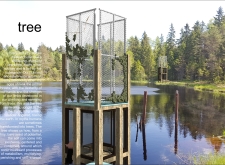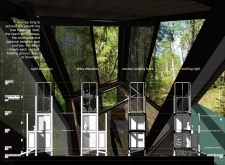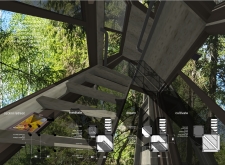5 key facts about this project
At its core, the design represents a fusion of modern techniques and traditional elements, creating a dialogue between the past and the present. The project's function is multifarious, combining residential, commercial, and communal spaces into a cohesive whole. This approach reflects an increasing trend in architecture that prioritizes mixed-use developments, encouraging interaction among different user groups and fostering a sense of community. The carefully considered spatial arrangement allows for dynamic flows of activity, promoting a vibrant atmosphere that is both inviting and practical.
One of the defining features of the project is its unique approach to materiality and construction. The architects have selected a palette of materials that not only enhances the aesthetic appeal but also underscores the project's commitment to sustainability. Key materials utilized include locally sourced timber, which not only reduces the carbon footprint but also adds warmth and texture to the structure. Complementing this, the use of stone cladding in certain areas provides a solid visual anchor, connecting the building more closely to its environment. Additionally, the incorporation of glass elements fosters a sense of transparency, allowing natural light to permeate the spaces and blurring the boundaries between indoor and outdoor environments.
The project showcases innovative design ideas that prioritize energy efficiency and environmental responsibility. Noteworthy features include green roofs, which not only enhance biodiversity but also provide insulation, thereby reducing energy consumption. The integration of rainwater harvesting systems reflects a comprehensive approach to resource management, further emphasizing the sustainability ethos underpinning the project. This thoughtful consideration of environmental impacts highlights the architects' dedication to creating spaces that are both functional and respectful of their ecological context.
In terms of unique design approaches, the project adopts a biophilic design strategy, which prioritizes connectivity to nature. This is achieved through the incorporation of extensive landscaping, terrace gardens, and communal courtyards that facilitate outdoor activities and interactions. The architects have designed these spaces to not only serve aesthetic functions but also to encourage social engagement among residents and visitors alike. This commitment to fostering community ties through thoughtfully designed outdoor spaces illustrates how architecture can facilitate human connections in an increasingly digital world.
The architectural composition of the project is marked by clean lines and a balanced relationship between volumes, creating an identity that is both modern and rooted in context. The articulation of different sections of the structure allows for visual interest while maintaining an overall coherence in design. Every aspect of the project is meticulously detailed, from façade treatments to the careful selection of fixtures and finishes, ensuring consistency in quality across all elements.
The interior spaces are equally considered, with a focus on user experience and functionality. Well-planned layouts promote ease of movement and allow for flexibility in use, catering to a diverse range of activities. The use of natural light not only enhances the aesthetic quality but also contributes to the overall well-being of occupants, embodying current trends in health-conscious design.
The architectural plans, sections, and details underpinning this project actively serve to communicate its intent and function. These documents offer deeper insights into the spatial organization and the relationship between various components, showcasing how each element works collectively to achieve the overall vision. Readers are encouraged to delve into the project presentation for a comprehensive look at these aspects, exploring how architectural designs and ideas have been implemented practically.
This project stands as a testament to the potential of thoughtful architectural design to enrich our built environment. It invites further exploration into the nuances of its design, urging interested individuals to review all the architectural elements and gain a deeper appreciation of the work. Engaging with the project's various dimensions will reveal rich details that contribute to its identity, making it a valuable reference in contemporary architectural discourse.


























